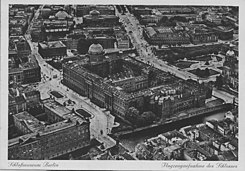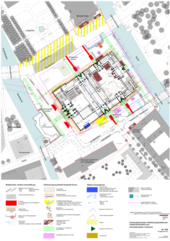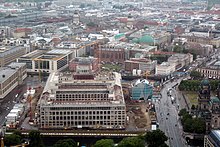Schloßplatz (Berlin)
| Schlossplatz | |
|---|---|
| Place in Berlin | |
 Aerial view with Schlossplatz (left) and Lustgarten (right), around 1900 |
|
| Basic data | |
| place | Berlin |
| District | center |
| Confluent streets |
Rathausstrasse , Breite Strasse , the former Brüderstrasse , Werderscher Markt , Schloßfreiheit |
| Buildings |
Berlin Palace , New Marstall . Former buildings: |
| use | |
| User groups | Pedestrians , cyclists , road traffic |
The palace square in Berlin district center of the district of the same is a place on the Museum Island . Originally only the area south of the Berlin Palace with the palace fountain bore this name, today it is also used by the former Schloss Freiheit and the area north to the Lustgarten . Schloßplatz is surrounded by the New Marstall and the State Council building in the south, the former Kaiser Wilhelm National Monument in the west and the Berlin Cathedral in the north. In connection with the reconstruction of the Berlin Palace as a Humboldt Forum , the square will be redesigned by 2023.
history
Before the fortification of what would later become the Schlossplatz, this was the end of the Stechbahn, a facility for tournament games that Elector Joachim II had built in 1537. After the tournament area was removed , the street An der Stechbahn , which led into the Schlossplatz, was a reminder of this , but this disappeared due to a change in the buildings in 1866. The former palace stood between three squares - the Lustgarten in the north, the Schloss Freiheit on the Spree Canal in the west and the historic Schlossplatz in the south. In 1830 there were mass gatherings and riots in the square during the tailoring revolution. In 1891 the castle fountain designed by Reinhold Begas , a gift from the magistrate to Kaiser Wilhelm II , was erected on the Schloßplatz . Today the fountain is called Neptune Fountain .
After the Second World War , the damaged castle should first be rebuilt. A plan of city building director Richard Ermisch also foresaw that was originally on the Rathausbrücke located equestrian statue of the Great Elector regroup on the eastern edge of the Schlossplatz. Nevertheless, despite numerous international protests , the palace was blown up in 1950 by decision of the Politburo of the Central Committee of the SED . The castle or Neptune fountain was stored and set up in 1969 on the open space between the Marienkirche and the Rotes Rathaus . In 1951 the cleared area was given the name Marx-Engels-Platz together with the pleasure garden as well as the castle freedom and the historic castle square . In October 1951, the square served as the start and finish point and the opening and closing stages of the GDR tour . A grandstand built for the party and state leadership of the GDR was placed on the east side parallel to the Spree. The rest of the area served as a parade ground for large demonstrations and military parades. In 1973 the construction of the Palace of the Republic , which was opened in 1976, began in place of the grandstand on the eastern part of the former palace area . In 1990, however, the building was closed due to asbestos contamination.
After the political change , archaeological excavations were carried out in the undeveloped area of the castle area , with part of the castle foundations and cellar areas being exposed. In 1991, the northern part of the Marx-Engels-Platz got back its original name Lustgarten back, while in 1994 to rename the rest of Marx-Engels-Platz Schlossplatz came. Further excavations since 2008 also uncovered the foundations of the Dominican monastery in Cölln . After its asbestos removal from 1997 to 2002, the Palace of the Republic was demolished between 2006 and 2008. In order to allow the resulting fallow land to be used temporarily, the area was then designed with lawns, wooden walkways and seating steps. The temporary use ended at the beginning of 2013 and complete dismantling began in preparation for the reconstruction of the city palace.
Since 2013 Federal decision is of 2002, a new development in the area on the lock according to the outer dimensions built of the old castle, wherein three baroque lock walls (north, west and south) and the Schlüterhof be reconstructed. The east side of the Spree will be designed in a modern way. On June 12, 2013, Federal President Joachim Gauck laid the foundation stone for the new building, which is to be used as the Humboldt Forum. Until the opening (according to the current planning status for 2019), the exhibitions in the temporarily erected Humboldt Box at Schloßplatz 5 will provide information about the building project and the concepts for the Humboldt Forum.
On April 13, 2011 it was announced that in the competition for the planned Freedom and Unity Monument on the base of the former Kaiser Wilhelm National Monument on the Schloss Freiheit , d. H. in the immediate vicinity of Schloßplatz, a decision has been made by the jury. The monument "Citizens in Motion" by the architect Johannes Milla and the choreographer Sasha Waltz is to be built in the form of a large walk-in seesaw. The aim is to show that many people can bring about great changes.
Castle fountain in its original location, around 1900
Freedom of the castle with the Kaiser Wilhelm National Monument , around 1900
View over Marx-Engels-Platz in northeast direction to the Berlin Cathedral , 1951
View over Marx-Engels-Platz in south-east direction to the New Marstall , 1951
Marx-Engels-Platz with the Palace of the Republic , 1986
Open space design

In January 2013 the Berlin office bbz Landschaftsarchitekten received the 1st prize in the competition "Open space design environment Humboldtforum". The draft envisages a contemporary design of the castle surroundings, which however allows a return of historical elements. These include the eagle column on the corner of the palace bridge, the horse tamers at the Lustgarten and the Neptune fountain at the palace square. According to a representative survey by infratest dimap in May 2017, the vast majority of the population (65%) are in favor of a historic castle environment; only a small proportion (20%) prefer the contemporary variant.
Originally, the open space design was supposed to be completed together with the Humboldt Forum in 2019. At the end of December 2018, however, the responsible Senate Building Department announced that the area around the palace will probably not be completed until 2023 due to the construction of the underground .
spelling, orthography
The official name change back to Schloßplatz happened in 1994, before the ß- spelling reform . After this reform it would have to be called Schlossplatz , but as is generally the case, the street name or, in this case, the square name was not changed. The same applies to other castle phrases such as castle fountain, freedom, bridge in connection with the Berlin City Palace . These proper names are used here as they were used according to the spelling that was valid at the time.
literature
- Beate Binder: Dispute in the city center: the Berlin Schloßplatz , Böhlau, Cologne / Weimar / Vienna 2009, ISBN 978-3-412-20040-4 (Habilitation Humboldt University Berlin 2006/07).
- Monika De Frantz: Capital City Cultures: Reconstructing Contemporary Europe in Vienna and Berlin (= Multiple Europes , Vol. 45). Peter Lang, Bern a. a. Vienna 2011, ISBN 978-3-0352-6163-9 / ISBN 978-90-5201-739-6 (modified dissertation European University Institute Fiesole 2004).
- Alexander Barti: The Palace Square Debate . A German decision. Südwestdeutscher Verlag für Hochschulschriften, Saarbrücken 2012, ISBN 978-3-8381-3045-3 ( publisher's text ).
- Michael Malliaris : The building history of the Dominican monastery area in Cölln on the Spree . Imhof, Petersberg 2019, ISBN 978-3-7319-0668-1 .
Web links
- Schlossplatz. In: Street name lexicon of the Luisenstädtischer Bildungsverein (near Kaupert )
- Marx-Engels-Platz . In: Luise.
- Dossier on Berlin's Schloßplatz. In: Der Tagesspiegel , 2006/2007
- Berlin 1880: 3D models of the center of Berlin around Schloßplatz, accessed on February 22, 2018
- Kurt-Michael Borchert, Christian Götz Hirschberg: The subsoil conditions and foundation possibilities in the area of the Schloßplatz in the historic center of Berlin , in: Baukammer Berlin 2/1998 (PDF; 2.8 MB)
Individual evidence
- ↑ https://architekturmuseum.ub.tu-berlin.de/P/84639.php
- ↑ Wooden walkways on Schlossplatz will be dismantled - transitional use will end after three years. Senate Department for Urban Development and the Environment, December 20, 2012, accessed on December 24, 2012 .
- ^ Resolution of the German Bundestag of July 4, 2002 ( Memento of October 14, 2013 in the Internet Archive )
- ^ The unitary monument becomes a swing In: Der Tagesspiegel , April 14, 2011
- ↑ Open space planning realization competition "Open space design environment Humboldt Forum" / State of Berlin. Retrieved June 4, 2017 .
- ↑ Survey: Half of Berliners are against the unified monument . ( bz-berlin.de [accessed June 4, 2017]).
- ↑ Isabell Jürgens: The Berlin Palace will remain a major construction site until 2023. December 23, 2018, accessed December 25, 2018 (German).
- ↑ Monika De Frantz will defend her thesis, Wednesday October 27, 2004, 5–7 pm, Cappella, Villa Schifanoia, Department of Political and Social Sciences.
Coordinates: 52 ° 31 ′ 3 ″ N , 13 ° 24 ′ 10 ″ E









